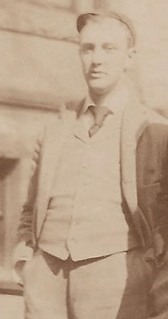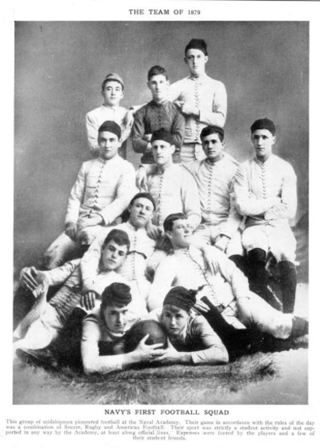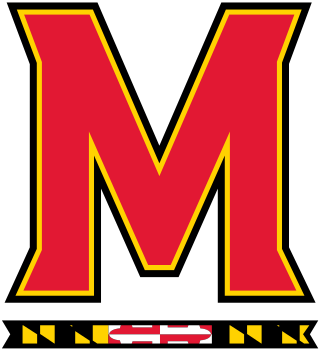
Robert Means Thompson Stadium was an American football stadium in the eastern United States, located on the campus of the United States Naval Academy in Annapolis, Maryland. Constructed in 1914, it was the home stadium of the Navy Midshipmen from 1924 through 1958, and was named after alumnus Robert Means Thompson (1849–1930). He created or led several athletically-based organizations at the academy until his death. It was succeeded by the larger Navy–Marine Corps Memorial Stadium in 1959, the current venue of Navy football.

The Navy Midshipmen football team represents the United States Naval Academy in NCAA Division I FBS college football. The Naval Academy completed its final season as an FBS independent school in 2014, and became a single-sport member of the American Athletic Conference beginning in the 2015 season. The team is currently coached by Brian Newberry, who was promoted in 2022, following his stint as the Midshipmen defensive coordinator. Navy has 19 players and three coaches in the College Football Hall of Fame and won the college football national championship in 1926 according to the Boand and Houlgate poll systems. The 1910 team also was undefeated and unscored upon. The mascot is Bill the Goat.

Benjamin Lewis Crosby Jr. was an American college football player and coach. Born in Halcott Centre, New York, Crosby attended Yale University beginning in 1889; while there, he was a popular student and sportsman. He was a two-year starter on the football team and a backup on the crew team. During his junior year, he was replaced on the football team by freshman Frank Hinkey and never returned to a starting position. The remainder of Crosby's time at Yale was successful and he enrolled at the New York Law School after graduation.

Vaulx Carter was an American college football player and engineer who is best remembered as the first coach of the Navy Midshipmen football program. He was born in Tennessee and raised there for part of his childhood, until he was orphaned and adopted by family members in Pennsylvania. Starting in 1880, Carter attended the United States Naval Academy; he struggled academically at the school, only excelling in his art classes. Carter failed his final examinations in his final two years at the academy and was recommended for removal following the second failure. This did not happen, as he was forced to voluntarily resign from the school in 1883 due to permanent injuries received from an accident.

The Johns Hopkins Blue Jays football team represents Johns Hopkins University in the sport of American football. The Blue Jays compete in Division III of the National Collegiate Athletic Association (NCAA) as members of the Centennial Conference. Johns Hopkins has fielded a team since 1882. Johns Hopkins has won or shared 13 Centennial Conference titles since the 2002 season, including 10 straight titles through the 2018 season.

The 1879 Navy Midshipmen football team represented the United States Naval Academy in the 1879 college football season. The team was the 1st season intercollegiate football squad to represent the United States Naval Academy. The team had no coach, as it was entirely student-operated; however, it was captained by squad member Bill Maxwell. The team played just a single game, which was a scoreless tie with the Baltimore Athletic Club. The team was entirely student operated, and was not supported by the Naval Academy's faculty. The school would not have another football squad until 1882.

The 1882 Navy Midshipmen football team represented the United States Naval Academy in the 1882 college football season. The team was the second intercollegiate football squad to represent the United States Naval Academy, and the first since 1879. The team was coached by player-coach Vaulx Carter, and was entirely student-operated. It was captained by squad member Alex Jackson. The team played just a single game, an 8 to 0 (8–0) shutout of Johns Hopkins, which was the school's first ever win. The squad was entirely student operated, and was not supported by the Naval Academy's faculty. The season would mark the beginning of eight season rivalry between the Midshipmen and Johns Hopkins.
The 1883 Navy Midshipmen football team represented the United States Naval Academy in the 1883 college football season. The team was the third intercollegiate football squad to represent the United States Naval Academy, and the first time the school participated in consecutive seasons. The squad was captained by member Frank Hill. The team played just a single game, a 2 to 0 (2–0) shutout loss to Johns Hopkins, which was the school's first ever loss. The squad was the first to have the approval of the academy's staff, and is regarded as the first official game played by the Midshipmen. The season continued a seven-season, eight game rivalry between the Naval Academy and Johns Hopkins.

Worden Field is a large grass field located on the campus of the United States Naval Academy in Annapolis, Maryland. First mentioned in 1890, the field served as the home stadium for the academy's Midshipmen football team from that year through 1923, replaced by Thompson Stadium in 1924. Since the early 1900s, the field has hosted all of the academy's various yearly parades and many of its drills. It has progressively grown smaller, due to the addition of buildings and roads within the academy.

The Johns Hopkins–Navy football rivalry was an American intercollegiate football rivalry between the Johns Hopkins Blue Jays football team of Johns Hopkins University and the Navy Midshipmen football team of the United States Naval Academy. The two institutions, located within the span of a few miles in the state of Maryland, first met for a football game in 1882. Following the initial contest, both teams played each other annually for eight years, before it was called off for unknown reasons. The teams competed again in 1911 and 1912, again disbanding the contest until a final match took place in 1919.
The 1884 Navy Midshipmen football team represented the United States Naval Academy in the 1884 college football season. The team was the fourth intercollegiate football squad to represent the United States Naval Academy, and was the final time the school played a single-game season. The squad was captained by rusher Jim Kittrell. The team's single game was a 9 to 6 (9–6) defeat of rival-school Johns Hopkins. The season continued a seven-season, eight game rivalry between the Naval Academy and Johns Hopkins. It was the final season that a Naval Academy team would go unbeaten and untied.
The 1886 Navy Midshipmen football team represented the United States Naval Academy in the 1886 college football season. The team marked the second time that the school played a multiple-game season. The squad was captained by halfback Clarence Stone. The year began with consecutive wins over rivals St. John's College and Johns Hopkins, but then regressed with a loss to the former and a close victory over the latter. The year concluded with shutout losses to the Princeton reserve squad and Gallaudet. The season was the program's longest until 1890, when that year's team played seven games.

Charles Cabaniss was a midshipman in the United States Navy and early player of American football. Born and raised in Central Virginia, he was appointed to the United States Naval Academy at the age of 16. At the academy, Cabaniss retained average-level grades and was a member of the school's first-ever football team. He graduated in 1880 and was appointed to the USS Swatara. Cabaniss was killed in an accident on the Swatara in 1882 which received coverage throughout much of the Eastern United States.
The 1889 Navy Midshipmen football team represented the United States Naval Academy during the 1889 college football season. The team compiled a 4–1–1 record and outscored opponents 112 to 42 In the ninth installment of the Johns Hopkins–Navy football rivalry, Navy won by a 36 to 0 score. The team captain was Albertus Catlin.
The 1888 Navy Midshipmen football team represented the United States Naval Academy during the 1888 college football season. The team compiled a 1–4 record and were outscored by its opponents 73 to 35. In the eighth installment of the Johns Hopkins–Navy football rivalry, Navy lost by a 25 to 12 score. In the final game of the 1888 season, the Midshipmen lost to St. John's College by a 22–6 score, with a brawl breaking out at the end of the game. The team captain was George Hayward.
The 1887 Navy Midshipmen football team represented the United States Naval Academy during the 1887 college football season. The team compiled a 3–1 record and outscored its opponents 41 to 22. The Midshipmen shut out their first three opponents, including an 8–0 victory in the seventh installment of the Johns Hopkins–Navy football rivalry. The Johns Hopkins game was played at the Academy grounds in Annapolis, Maryland, and was described by The Sun as "a veritable slugging match" and "one of the roughest games of football" ever seen there. In the final game of the 1887 season, the Midshipmen lost to the Princeton Tigers "B" team in the final game of the season. The team captain was George Hayward.
The 1882 Clifton Athletic Club football team represented Johns Hopkins University in the sport of American football during the 1882 college football season. Hopkins' first team was assembled in 1881, and spent an entire year training and learning a version of the game. Their sport, which was closer to rugby, was played in Druid Hill Park. After the training, the team planned a two-game 1882 season. The squad had to play the season under the title of the Clifton Athletic Club, due to the school's policy on the sport of football. The first was a practice game with the Baltimore Athletic Club, played on October 7. The Hopkins team lost the contest 4–0. The following game was their first true game, to be played against the Naval Academy.

The Army–Navy lacrosse rivalry is an intercollegiate lacrosse rivalry between the Army Black Knights and the Navy Midshipmen. The two programs, historical rivals in other sports like football and soccer, have a fierce and nationally-relevant rivalry in lacrosse as well. With 25 national championships, 10 Final Fours in the NCAA era, and 190 consensus first team All-Americans, the two teams have been integral to the game's history. The rivalry carries a different spirit than many others in collegiate lacrosse, described by former Navy goalie Ryan Kern as: "t’s the same camaraderie that you had in the fall with the football game and it kind of comes out again in the spring with the lacrosse game,” Navy junior goalie Ryan Kern said. “No doubt, all the other sports are important, but just the sheer number of people that come to this game is crazy — just like the football game. You see 16,000 people come to a regular season lacrosse game, and that’s not happening at other lacrosse programs." After 101 meetings, Navy leads the series 62–36–3 through 2021.

The Maryland–Navy lacrosse rivalry is an intercollegiate lacrosse rivalry between the Maryland Terrapins and Navy Midshipmen. Hailing from College Park and Annapolis, the state rivals have another historical series in college football, known as the Crab Bowl Classic. In lacrosse, the teams first met in 1924 and have met annually since 1927, aside from brief interruptions due to World War II and the COVID-19 pandemic. Prior to Maryland upgrading its club team to varsity in 1924, the teams met seven additional times, with Navy winning five of those. However, these do not count in the official record. Traditionally taking place in either April or May, the game has been moved up to the earlier months of the season to accommodate the teams' increasing difficulty to schedule non-conference games, compounded by the expansion of the Patriot League and Maryland's decision to join the Big Ten Conference. Despite concern that the series may have to be postponed indefinitely, the teams have maintain the annual series, though it has at times been played mid-week rather than as the weekend headliner.

The Johns Hopkins–Navy lacrosse rivalry is an intercollegiate lacrosse rivalry between the Johns Hopkins Blue Jays and Navy Midshipmen. While historical rivals in football, the lacrosse series has been the headlining competition between the two universities. The Maryland programs were both national powers prior to NCAA sponsorship of the sport, with 35 national titles for the Blue Jays and 17 for the Midshipmen. They both continue to rank one-two in the most total national championships of any program in collegiate lacrosse. While both mainstays on the national stage in the modern era, Hopkins has dominated Navy head-to-head, winning 36 consecutive from 1975 to 2009. The series, annual since 1950 was halted in 2017 due to scheduling issues from conference realignment, as the longtime independents joined the Patriot League and Big Ten Conference respectively in the last decade. A 2020 renewal was cancelled due to the COVID-19 pandemic. As of 2020, Johns Hopkins leads the series 62–27–1.










